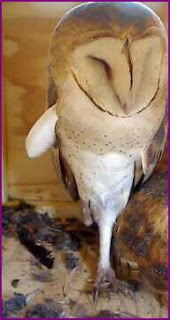Q: Why does that Owl only have one leg?
Q: Is that owls leg hurt?
The truth is that it is very common among Barn owls and most birds to stand on one leg.
Birds, like other animals, shift their weight occasionally in order to avoid muscle and tendon strain, especially when perching.
When they sleep or rest they often raise one foot, later the other, which is more or less the same as a human rolling over in bed.
In cold weather, they alternate raising their feet up into the insulation and warmth of their feathers in order to avoid frostbite.
When they need to take off, they use both feet to get a boost from their powerful thigh muscles.
Owls’ legs have an adaptation called “rete mirabile” that minimizes heat loss.
The arteries that transport warm blood into the legs lie in contact with the veins that return colder blood to the bird’s heart, arteries warm the veins.
In the winter by standing on one leg, an owl reduces half the amount of heat lost through unfeathered limbs.

